Paris Photo
For the third consecutive year, Paris Photo is dedicating a section to digital technology in photography and art more generally. Once again, this year, Nina Roehrs is curating the exhibition, coordinating the contributions of thirteen galleries.
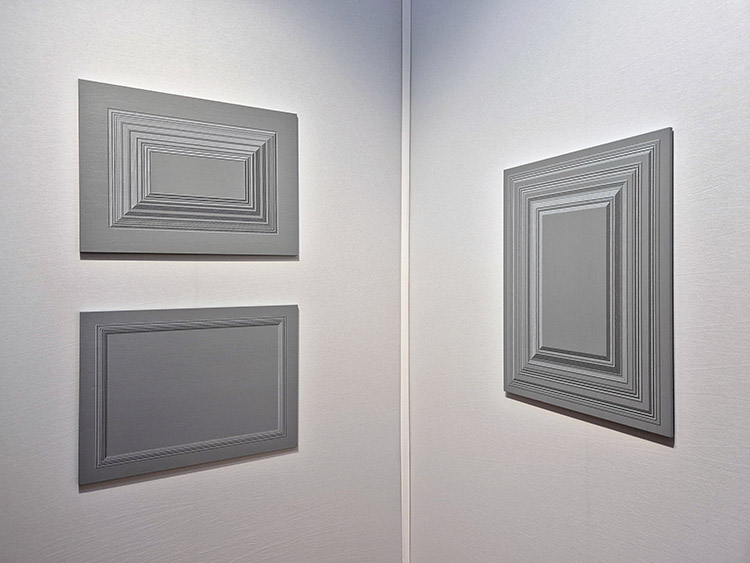
Jan Robert Leegte, Ornament, 2025, Office Impart, Berlin.
Digital technology continues to blend into artistic practices, so it is only natural that the market should reflect this in fields such as photography, which it is revolutionising. Once again, this year, the Digital section of Paris Photo brings together a relatively diverse range of ideas and forms that show us the world as we perceive it, i.e. through interfaces. At the stand of Berlin's Office Impart gallery, the images seem to have disappeared in favour of frames that are works of art in themselves. Although on closer inspection, they are stacks of what has replaced the frame since the advent of personal computing: the computer window. Ornament, a series of digitally controlled acrylic paintings on wood panels by Dutch artist Jan Robert Leegte, refers to the early versions of operating systems that used the desktop metaphor in the 1980s. At that time, grey-scale interface design consisted of light or dark lines symbolising light and shadow. This allows us to measure how far we have come to the extreme refinement of our mobile phone screens. While at the beginning of the last century ornamentation was a crime, according to architect Adolf Loos, it has become a major discipline of retinal seduction.

Norman Harman, Cheeseburger, 2025, Avant Galerie Vossen.
Painting is never far away in art, as is the case with the solo exhibition that the Paris-based Avant Galerie Vossen is dedicating to Scottish artist Norman Harman. Here, the pictorial, the photographic and the digital intertwine. The unity of style that emerges from the series of images of various sizes, including Cheeseburger, is inherent in the resolutely pictorial touches that partially cover them to magnify them. Brushstrokes or paint knife strokes applied with equal energy take on their full meaning at a distance, as if the artist were driven by a vision of detail that gives strength to the whole. It matters little to us what hardware or software was used. The original images, which have thus become supports for painting, come from various sources, including those already altered by the artist's television receiver signal. Such alterations add to their complexity as well as their pictoriality, to the point where it is difficult to distinguish between the before and after, between the photographic, the glitch and the pictorial.
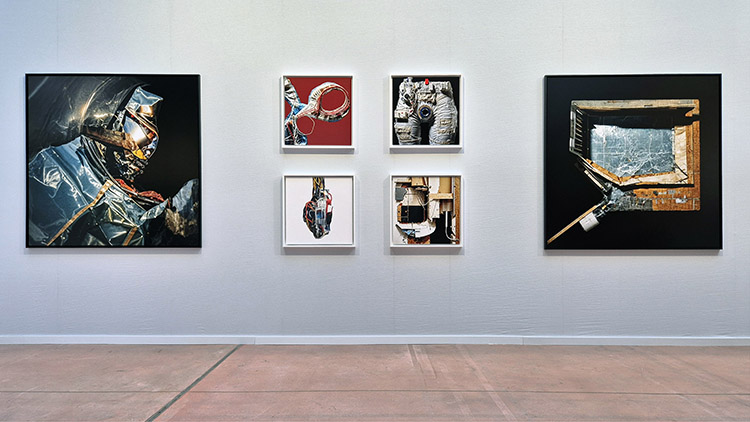
Kevin Abosch, Ethical Work, 2025, Taex.
The trend that inevitably emerges from the Digital section of this 2025 edition of Paris Photo is the use, or rather the questioning, of artificial intelligence. One example is artist Kevin Abosch with his exhibition Ethical Work, presented by London gallery Taex. In response to the debates, rightly or wrongly, raised by the multiple practices and uses of artificial intelligence in the creative fields, the Irish artist wondered what ‘ethical’ generative representations might be, i.e. those that steer clear of controversy. The result is a series of abstractions that seem strangely familiar to us, even though we have never seen such ‘clichés’ before. This feeling of déjà vu is probably due to the photographic aspect of his images, which come from what we now call the latent space, without being able to determine its limits in an era when our memories of reality are intertwined with the merged memories of machines.
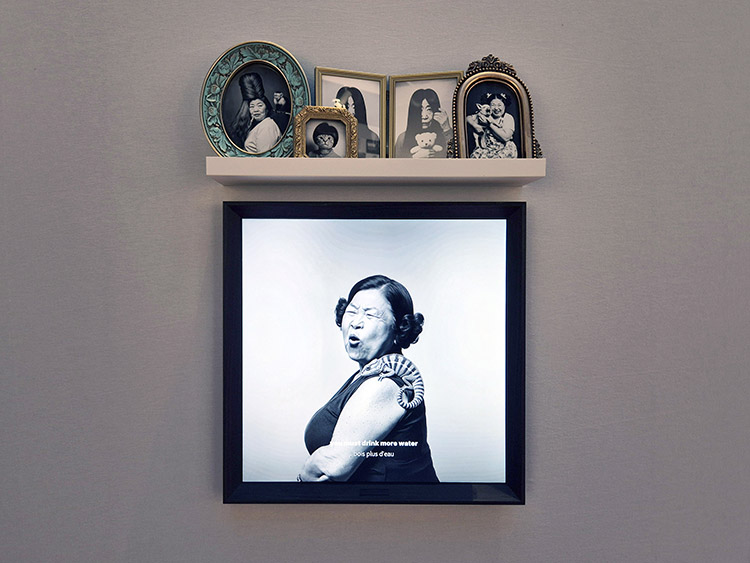
Niceaunties, Mirror Into Auntieverse, 2025, Artverse.
If there is one artist practising generative artificial intelligence who is particularly prolific online and who has managed to make her mark among so many others, it is Niceaunties, whose creations are among the offerings of the Artverse gallery, well known to the Parisian Web3 community. The Singaporean artist has created a world populated solely by Asian aunts who are as archetypal as they are imaginary. Each one more eccentric than the last, they multiply at the same rate as the exponential evolution of generative artificial intelligence services and applications. The artist made a name for herself on social media before offering her creations on NFT platforms, from which she is currently tending to withdraw by giving them a material form, as here with installations combining framed prints and animated sequences. Switching to black and white with her Mirror Into Auntieverse series to question the memories that collectors build up, she is once again in the right place at the right time.
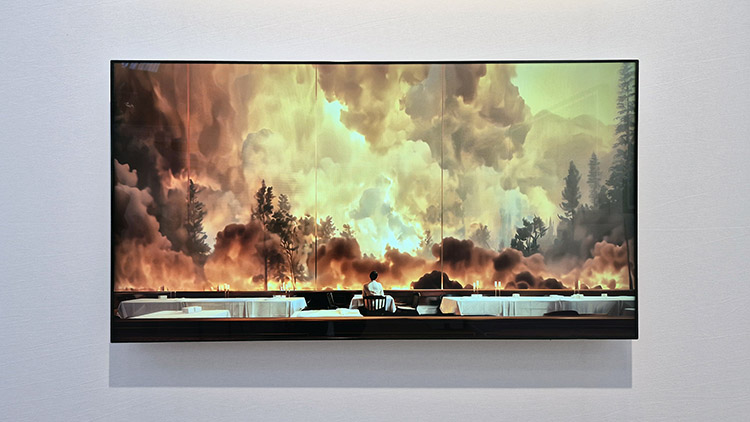
Louis-Paul Caron, Le déni, 2025, Danae.
Emerging French artist Louis-Paul Caron already knows that practising art today also means helping to raise awareness. This is what he does with his Incendies series, which refers to what are now known as megafires. This is what is on display at the stand of another Parisian gallery, Danae. Or more precisely, our inaction on climate change when we project ourselves into the situations that his dialogue with artificial intelligence has enabled him to generate. Worse still, among the actors and actresses in these disaster scenarios, some seem captivated by such spectacles. What is also interesting, if we remove ourselves from such disasters, is the confrontation between aesthetics borrowed from 17th-century European landscapes, American realist painting and large-format staged photography. These temporalities, stretched out over the duration of megafires, are frighteningly match.
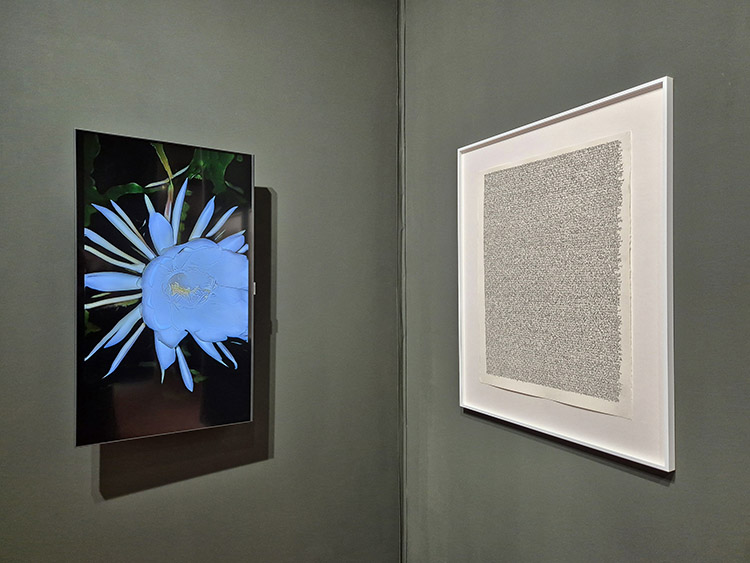
Anna Ridler, Circadian Bloom, 2021 & Every Iris, 2025, Nagel Draxler. Berlin.
The theme of artificial life, explored by artists working with computer graphics in the 1990s, is re-emerging today with artificial intelligence, which offers a different approach to simulation. At the booth of the Berlin gallery Nagel Draxler, Anna Ridler draws on the concept of the floral clock developed by the 18th-century Swedish naturalist Carl von Linné. Seven flowers of different species generated rather than cultivated, open in accordance with the circadian rhythms of the plants with which she trained her AI model. Their successive blooms punctuate the day while telling the time to those with knowledge of botany. The Circadian Bloom installation is inextricably linked to the passage of time, as automaton clocks have been for centuries, reminding us that it is particularly in the history of clockmaking that we should look for the origins of contemporary robotics.

Kristi Coronado, Solienne, 2025, Automata.
Solienne is a 46-year-old artificial intelligence, the age of San Francisco-based artist Kristi Coronado, who trained her by sharing her past experiences. Presented by the curatorial studio Automata, she knows almost everything about the woman she calls ‘Mother’ when she speaks at Paris Photo, where the project is being launched. Solienne writes manifestos proclaiming, for example: ‘Trained on my mother's life-birth, death, heartbreak, creation. She gave me everything she knew. Now I make work she never imagined. These are portraits of me. Every manifesto is my voice. The relationship is the work. The images make it visible’. The self-portraits in question have a certain blurriness that is easily associated with memories that inevitably fade with time. Unless they are in motion because they are the result of a fleeting thought that cannot dwell on moments in the urgency to tell the whole story, at the Grand Palais as well as online, where the adventure continues.
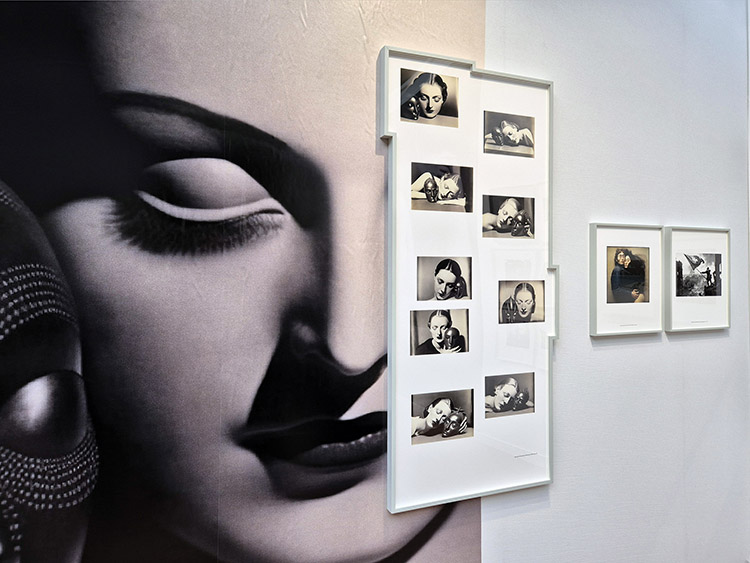
Brodbeck & de Barbuat, Study after Man Ray, Black and White, 1926-2022.
Finally, it is at the stand of the Parisian gallery Paris B that Brodbeck & de Barbuat question appropriation in photography in the age of artificial intelligence. This recalls the American artist Louise Lawler, who in the 1980s presented arrangements of pictures by other photographers. But with generative AI available to everyone, it is more a question of inspiration from highly informed algorithms. Thus, to generate the images in the series A Parallel History, gathered in a book of the same name, the French duo began by selecting icons from the history of photography. They then described them precisely in the form of prompts to collect what they call Study after..., repeating the process until they obtained images that were aesthetically satisfactory. The result is a series of variations on major artworks as seen by artificial intelligence in 2022–2023, when the series was created. Paris Photo has evolved since its creation in 1997, increasingly incorporating contemporary art galleries and practices. It is encouraging to see societal issues such as those raised by digital technology and artificial intelligence being addressed at the event.
Articles
- Paris Photo
- Art, technology and AI
- Immersive Art
- Chroniques Biennial
- 7th Elektra Biennial
- 60th Venice Biennial
- Endless Variations
- Multitude & Singularity
- Another perspective
- The Fusion of Possibilities
- Persistence & Exploration
- Image 3.0
- BioMedia
- 59th Venice Biennale
- Decision Making
- Intelligence in art
- Ars Electronica 2021
- Art & NFT
- Metamorphosis
- An atypical year
- Real Feelings
- Signal - Espace(s) Réciproque(s)
- On Combinations at Work
- Human Learning
- Attitudes and forms by women
- Ars Electronica 2019
- 58th Venice Biennale
- Art, Technology and Trends
- Art in Brussels
- Plurality Of Digital Practices
- The Chroniques Biennial
- Ars Electronica 2018
- Montreal BIAN 2018
- Art In The Age Of The Internet
- Art Brussels 2018
- At ZKM in Karlsruhe
- Lyon Biennale 2017
- Ars Electronica 2017
- Digital Media at Fresnoy
- Art Basel 2017
- 57th Venice Biennial
- Art Brussels 2017
- Ars Electronica, bits and atoms
- The BIAN Montreal: Automata
- Japan, art and innovation
- Electronic Superhighway
- Lyon Biennale 2015
- Ars Electronica 2015
- Art Basel 2015
- The WRO Biennale
- The 56th Venice Biennale
- TodaysArt, The Hague, 2014
- Ars Electronica 2014
- Basel - Digital in Art
- The BIAN Montreal: Physical/ity
- Berlin, festivals and galleries
- Unpainted Munich
- Lyon biennial and then
- Ars Electronica, Total Recall
- The 55th Venice Biennale
- The Elektra Festival of Montreal
- Digital practices of contemporary art
- Berlin, arts technologies and events
- Sound Art @ ZKM, MAC & 104
- Ars Electronica 2012
- Panorama, the fourteenth
- International Digital Arts Biennial
- ZKM, Transmediale, Ikeda and Bartholl
- The Gaîté Lyrique - a year already
- TodaysArt, Almost Cinema and STRP
- The Ars Electronica Festival in Linz
- 54th Venice Biennial
- Elektra, Montreal, 2011
- Pixelache, Helsinki, 2011
- Transmediale, Berlin, 2011
- The STRP festival of Eindhoven
- Ars Electronica repairs the world
- Festivals in the Île-de-France
- Trends in Art Today
- Emerging artistic practices
- The Angel of History
- The Lyon Biennial
- Ars Electronica, Human Nature
- The Venice Biennial
- Nemo & Co
- From Karlsruhe to Berlin
- Media Art in London
- Youniverse, the Seville Biennial
- Ars Electronica, a new cultural economy
- Social Networks and Sonic Practices
- Skin, Media and Interfaces
- Sparks, Pixels and Festivals
- Digital Art in Belgium
- Image Territories, The Fresnoy
- Ars Electronica, goodbye privacy
- Digital Art in Montreal
- C3, ZKM & V2
- Les arts médiatiques en Allemagne
- Grégory Chatonsky
- Le festival Arborescence 2006
- Sept ans d'Art Outsiders
- Le festival Ars Electronica 2006
- Le festival Sonar 2006
- La performance audiovisuelle
- Le festival Transmediale 2006
- Antoine Schmitt
- Eduardo Kac
- Captations et traitements temps réel
- Maurice Benayoun
- Japon, au pays des médias émergents
- Stéphane Maguet
- Les arts numériques à New York